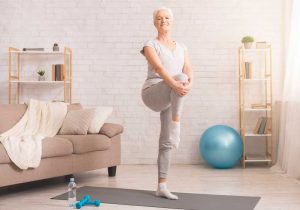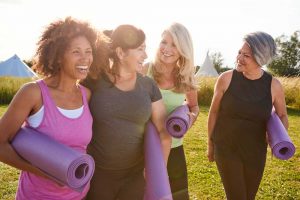
We’ve said it here before: women and men are not the same. Our beautiful bodies are created and develop differently.
Understanding and embracing these differences puts us in a better position to continue to get stronger, healthier and happier. In our very own skin.
This week – for Women’s Health Week – we’re going to explore some important differences and ways to modify your health and exercise routines to optimize results.
Difference 1: Knee Valgus
Women tend to have wider hips than men. This means our hips are wider than our knees and creates a tendency for our knees to collapse inwards – also known as knee valgus. We are therefore more susceptible to certain kinds of knee injuries and can be at particular risk during activities such as running, jumping and even walking down the stairs.
Creating more pelvic and hip stability, strengthening your glutes and increasing ankle range of motion are all factors that will improve knee alignment and keep some pesky pain and injuries at bay:
Strengthen your bum. Especially your glute medius and minimus which act to adduct and externally rotate your femur in your hip joint. Hip bridges, clams and squats with a band just higher than your knee joint are some effective options.
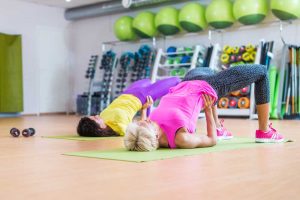
Work on patellar tracking. One legged step downs are terrific for encouraging the outside of those glutes to fire (remember that external rotation from above?!). Keep the platform relatively low. Start the movement by bending back from the hips and then bend the knee and ankle. Emphasizing the glutes and a stable pelvis for this movement will help keep the knee tracking over the toe instead of caving in. It will improve your balance and abdominal strength too!
Increase ankle mobility. Tight calves and ankles can cause the feet to pronate, forcing the shin bone and thigh bone to internally rotate encouraging those knees, once again, to cave in. Work on stretching AND strengthening the calve muscles. Eccentrically loading the calf by having your heel extend off a step and hold your body weight will encourage more active dorsiflexion and create strength through the calve in a lengthened position.
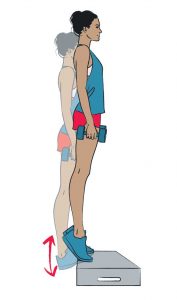
Difference 2: Arthritis Risk
One in 4 women – compared to one in five men – develop arthritis. To add to the challenge we experience worse pain and are far more vulnerable to rheumatoid arthritis – which can be extremely debilitating.
Here are a few things that can help:
Maintain a healthy body weight. Excess body weight can put extra pressure on the joints – eroding the cartilage and raising arthritis risk. So healthy eating and exercise to maintain a heathy body weight can be hugely beneficial.
Build your muscles. Having stronger muscles can alleviate the wear and tear on our joints. So pick up some weights, increase your muscle and joint strength and boost your metabolism at the same time!
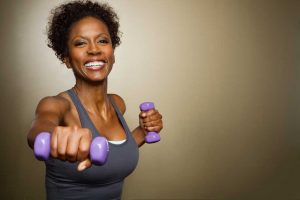
Keep moving. If you are currently struggling with arthritis pain, physical activity is still hugely beneficial. Find activities that don’t exacerbate the pain.
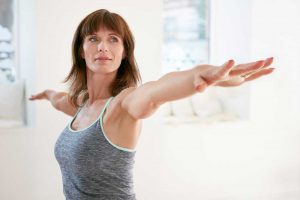
Difference 3: Body Composition:
Fat is essential for our survival. In both men and women, it insulates, protects vital organs, stores vitamins, supports our immune system and ensures optimal neurological function.
But while men have 3% essential body fat women need 12%. That’s right, in order to survive we need 4 times more essential fat. The reasons are quite complex but the main one of course is we are built – incredibly – with the ability to grow and nourish another human using our own reserves. Wow, right? We’re awesome.
So why is this difference important to understand? Here are a few vital things to consider:
Ensure your expectations in relation to weight and body composition are healthy and realistic. For example, a man might set a goal to attain a body composition of 12% body fat. On average 3% of that will be essential and 9% stored. This is considered a healthy goal. For a woman, the same healthy goal would be to achieve 21% body fat. (NOT 12%!!!!) As naturally 12% of that is essential but – like her male peer only 9% stored.
Men naturally carry more muscle. Right? If they are built to store less fat, their muscles (and bones incidentally) will weigh more. Having more muscle makes it easier to maintain more muscle. The take home? Weight train. And once you’ve learned great technique, periodically LIFT HEAVY. Not only does this help maintain lean tissue it will increase your body’s ability to burn fat and keep your energy and metabolism high. The best thing about weight training? It’s increases competence, confidence and body self-esteem.
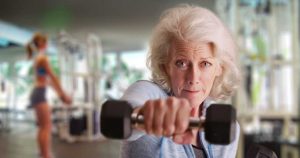
Difference 4: Bone Density
Directly related to different body compositions, compared to men, women tend to have smaller, thinner bones. We are also therefore more likely to get osteoporosis. In fact osteoporosis is 4 times more common in women. A second important factor being the sharp decrease in estrogen we experience when we reach menopause.
You are never too young or too old to take care of your bones. The best thing to do? Exercise.
Strengthen your feet. Since we’re all working out at home, take the opportunity to exercise with your shoes off. This will strengthen the bones in your feet which tend to weaken in women before anything else.
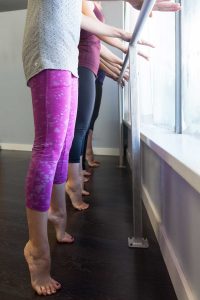
Move against gravity! Weight bearing activities including walking, jogging, and hiking are phenomenal for strengthening the lower limbs, hips, pelvis and lower part of the spine.
Lift weights. This is the most effective way of encouraging bone density maintenance and growth. Once you’ve mastered the techniques, commit to periods where you LIFT HEAVY. There is a growing body of research showing that 4-5 sets of lifting weight that are heavy enough you can only complete 5-6 repetitions is one of the best ways of increasing bone density in women over 58 years of age.
Find exercises that challenge your balance. One of the biggest risks associated with low bone mineral density is fractures. Better balance will decrease risk of falling.
